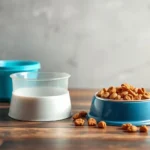
Proper nutrition is vital for any dog, and it’s especially crucial for Labrador Retrievers due to their unique health needs and predispositions. Labradors are known for their friendly demeanor and high energy levels, which require a balanced diet to support their lifestyle. However, affordability is also a key consideration for many pet owners who want to ensure their Labs receive the best nutrition without breaking the bank.
In this guide, we’ll explore the best affordable dog foods specifically tailored for Labs, considering their nutritional requirements, ingredients to look for, and more.
Understanding Labrador Nutrition Needs
Nutritional Requirements for Labs
Labrador Retrievers have specific nutritional needs that are crucial for their growth, energy, and overall health. The balance of macronutrients—proteins, carbohydrates, and fats—plays a significant role in their development.
- Proteins: Essential for muscle development and repair. Labs need high-quality, meat-based proteins to support their active lifestyles.
- Carbohydrates: Provide energy. Whole grains and vegetables are excellent sources of carbohydrates that can sustain their energy levels.
- Fats: Important for skin health and energy. Healthy fats, especially omega fatty acids, contribute to a shiny coat and healthy skin.
Vitamins and minerals are also important. They support immune function, bone health, and overall well-being, so ensure that your dog food contains a variety of these essential nutrients.
Common Health Concerns in Labs
Labradors are prone to certain health issues, making it crucial to monitor their diet closely:
- Obesity: Labs have a tendency to overeat, leading to obesity, which can cause joint problems, diabetes, and other health issues. A balanced diet can help maintain a healthy weight.
- Skin Allergies and Food Sensitivities: Some Labs may develop allergies or sensitivities, often related to specific ingredients in their food. Identifying and avoiding these can improve their health.
Life Stages and Dietary Changes
Labradors go through several life stages, each requiring different nutritional considerations:
- Puppies: Require higher protein and fat levels for growth. Look for puppy formulas specifically designed for large breeds.
- Adults: Should have a balanced diet aimed at maintaining a healthy weight and energy levels.
- Seniors: May need lower-calorie diets to prevent weight gain, along with added joint support supplements.
Adjusting your Lab’s diet according to their age and activity level is essential for their health.
Key Ingredients to Look For
Quality Proteins
When selecting dog food, prioritize meat-based proteins. Look for protein sources like:
- Chicken: A common and digestible protein source.
- Beef: High in protein and iron.
- Fish: Rich in omega fatty acids, beneficial for skin and coat health.
Avoid foods that list vague terms such as “meat by-products” as primary ingredients, as these can often indicate lower quality.
Healthy Fats
Healthy fats are crucial for Labs, especially omega fatty acids. These fats help maintain skin and coat health and provide energy. Good sources include:
- Fish Oil: Excellent for promoting a shiny coat and reducing inflammation.
- Flaxseed Oil: A plant-based source of omega-3 fatty acids.
Whole Grains vs. Grain-Free
The debate over grains in dog food continues, but both options have their merits:
- Whole Grains: Ingredients like brown rice and oats are digestible and provide energy. They also offer fiber, which is beneficial for digestion.
- Grain-Free Options: Some Labs may thrive on grain-free diets, but it’s important to ensure that the food still provides balanced nutrition.
Always consult with your veterinarian if you’re considering a grain-free diet for your Lab.
What to Avoid in Dog Food
Fillers and Artificial Additives
Avoid dog foods that contain fillers such as corn, soy, or wheat. These ingredients provide little nutritional value and can lead to weight gain and digestive issues. Additionally, steer clear of:
- Artificial Preservatives: These can have adverse effects on your dog’s health.
- Colorings: Often unnecessary and can indicate lower quality.
Low-Quality Proteins
Look out for dog foods that list by-products or unspecified animal sources as primary ingredients. Low-quality proteins can negatively affect your Lab’s health, leading to poor muscle development and overall vitality.
Top Affordable Dog Food Brands for Labs
When searching for best affordable dog foods for Labs, several brands stand out for their quality and price. Here’s a closer look at some top choices:
Brand Reviews
- Purina Pro Plan
- Nutritional Analysis: High-quality protein sourced from real meat. Balanced with fats and carbohydrates.
-
Ingredients: Chicken, rice, and essential vitamins.
-
Hill’s Science Diet
- Nutritional Analysis: Offers tailored nutrition for Labs at all life stages.
-
Ingredients: Real chicken, whole grains, and a blend of vitamins.
-
Blue Buffalo Life Protection
- Nutritional Analysis: Contains real meat, whole grains, and a precise blend of antioxidants.
-
Ingredients: Deboned chicken, brown rice, and barley.
-
American Journey
- Nutritional Analysis: Rich in protein and omega fatty acids, affordable pricing.
-
Ingredients: Salmon, sweet potatoes, and peas.
-
Merrick Grain-Free
- Nutritional Analysis: High protein content with no fillers or artificial additives.
-
Ingredients: Deboned beef, sweet potatoes, and peas.
-
Canidae Pure
- Nutritional Analysis: Limited ingredient diet ideal for Labs with sensitivities.
- Ingredients: Meat (various options), sweet potatoes, and probiotics.
Comparison of Price Points
| Brand | Average Price per Bag | Protein Content | Grain-Free Option |
|---|---|---|---|
| Purina Pro Plan | $50 | 26% | No |
| Hill’s Science Diet | $55 | 24% | No |
| Blue Buffalo Life Protection | $60 | 25% | Yes |
| American Journey | $50 | 30% | Yes |
| Merrick Grain-Free | $70 | 38% | Yes |
| Canidae Pure | $60 | 32% | Yes |
This comparison helps to identify the best value for money based on nutritional content and pricing.
Homemade Dog Food Options
Benefits of Homemade Meals
Preparing homemade meals for your Lab can be rewarding and cost-effective. Some advantages include:
- Control Over Ingredients: You know exactly what goes into your dog’s food.
- Customization: Tailor meals to fit your Lab’s specific dietary needs or preferences.
Simple Recipes for Labs
Here are a couple of easy homemade dog food recipes:
Chicken and Rice
Ingredients:
– 2 cups of brown rice
– 1 cup of carrots, diced
– 1 cup of peas, frozen
– 1 ½ pounds of chicken breast
Instructions:
1. Cook the chicken in a pot of water until fully cooked.
2. In a separate pot, cook the rice according to package instructions.
3. Mix the cooked chicken (shredded), rice, carrots, and peas together and serve.
Nutritional Breakdown: High in protein and carbohydrates, suitable for active Labs.
Beef and Sweet Potato Stew
Ingredients:
– 1 pound ground beef
– 1 sweet potato, diced
– ½ cup green beans, chopped
– 4 cups of water
Instructions:
1. In a pot, brown the ground beef.
2. Add sweet potato and green beans, along with water.
3. Simmer until vegetables are tender.
Nutritional Breakdown: Rich in protein and fiber, great for digestive health.
Transitioning Your Lab to a New Diet
Signs Your Lab Needs a Diet Change
Watch for signs that your Lab may need a dietary change, such as:
- Weight gain or loss
- Changes in energy levels
- Digestive issues (diarrhea, vomiting)
- Skin irritations or allergies
How to Transition Gradually
Changing your Lab’s diet should be done gradually to avoid digestive upset. Here’s how:
- Week 1: Mix 25% new food with 75% old food.
- Week 2: Adjust to 50% new food and 50% old food.
- Week 3: Transition to 75% new food and 25% old food.
- Week 4: Fully switch to new food.
Monitor your Lab’s response throughout the process and consult your veterinarian if you notice any adverse reactions.
Conclusion
Choosing the best affordable dog foods for Labs is crucial for their health and happiness. By understanding their specific nutritional needs, key ingredients to seek out, and what to avoid, you can make informed choices that keep your Lab thriving. Always prioritize high-quality ingredients, and don’t hesitate to try homemade meals for variety and nutritional control. With the right diet, your Labrador can enjoy a long, healthy life filled with energy and joy.









